Introduction
The king of cats, the majestic and magnificent lion (Panthera leo) is, tragically, a vulnerable species. Their population has plummeted by 75 per cent in the last fifty years1https://www.wildcru.org/news/baselines-to-assess-decline-and-recovery-lions/, and there are only around 23,000 of them left in the whole of Africa.2https://www.iucnredlist.org/species/15951/231696234#population Uganda is home to around 400 of these vulnerable lions3https://www.monitor.co.ug/uganda/news/national/drop-in-number-of-lions-alarms-conservationists-4335180, but their population is drastically declining. Some sources even estimate that there are less than 200 individuals left in the country.4https://davidshepherd.org/news-events-insights/news/the-last-of-the-lion-kings/ Uganda’s lions are mainly found in the three largest savannah parks: Murchison Falls, Kidepo Valley, and Queen Elizabeth National Park.5https://uganda.wcs.org/Wildlife/Lions.aspx Lions have a lifespan of 19 years in the wild.6https://www.nationalgeographic.com/magazine/article/serengeti-lions
Fascinating facts
The kings and queens of cats
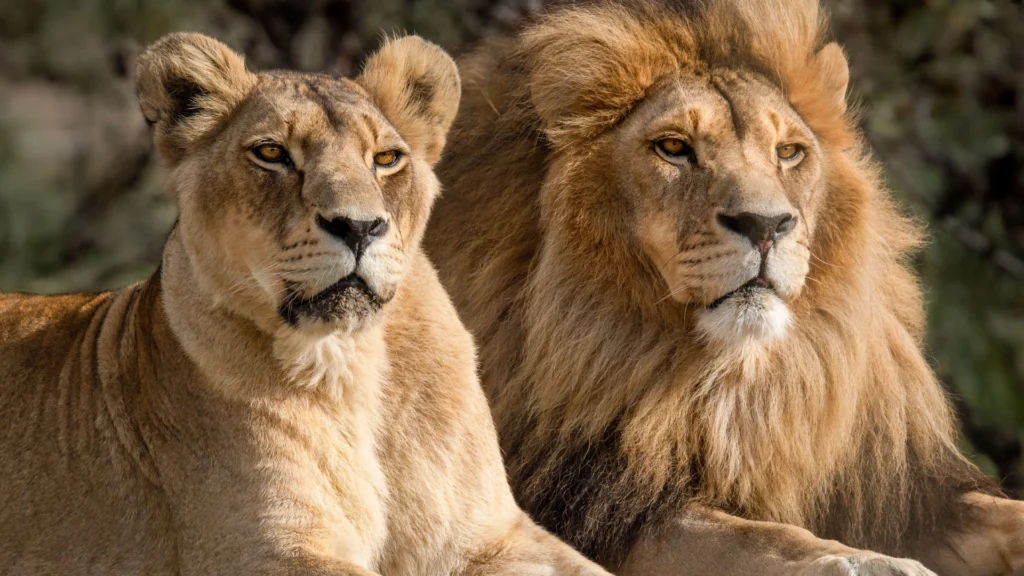
Not only are lions the most well-known big cat, they’re also the largest carnivore in Africa. Males can be up to a whopping eight feet (2.5 m) long with a three feet (1m) long tail, while females are a lot smaller at around one and a half metres (five feet) with a slightly smaller tail.7https://www.pbs.org/wnet/nature/blog/lion-fact-sheet/ Males weigh in at a hefty 30 stone (200 kg), while females are about 20 stone (130 kg).8https://www.wwf.org.uk/learn/fascinating-facts/lions
Femme fatale
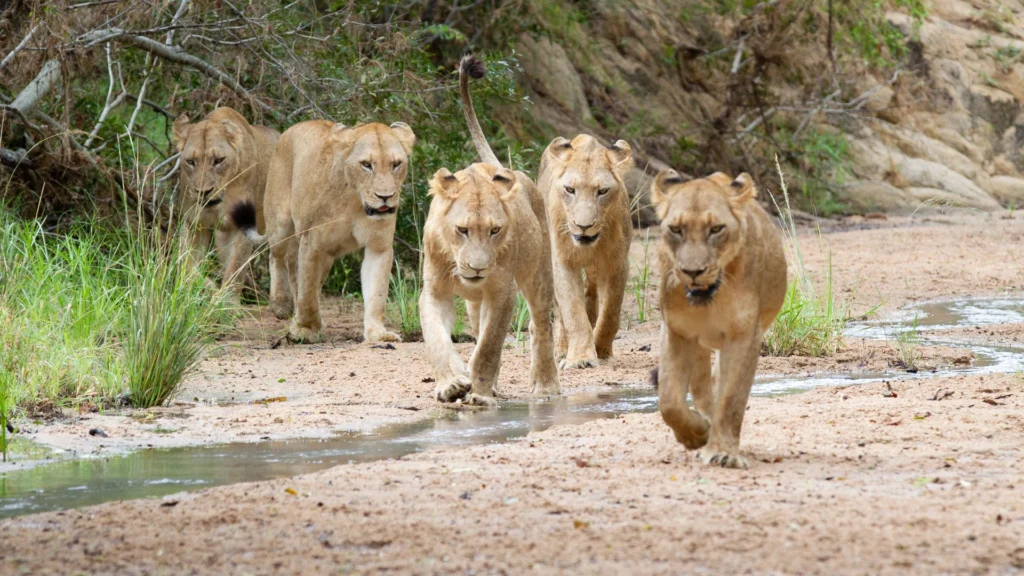
Lionesses living in open savannah often hunt cooperatively in small groups to stalk, surround and kill their prey. The males typically take their meals from the female’s kills. However, males may also be keen hunters and, in some areas, particularly scrub or woodland, they hunt most of their own meals. Lions are apex predators who mainly hunt at night. They play an important part in keeping the ecosystem balanced. Their prey vary in size from rodents and baboons to African buffalo. They mainly hunt medium- to large-sized hoofed animals such as wildebeest, zebra and antelope and stop these species becoming overpopulated. They also prey on sick animals, reducing disease, and readily clean up the carcasses of dead animals and steal fresh kills from other predators, such as cheetahs and hyenas.
Lions socialise more like chimpanzees than domestic cats
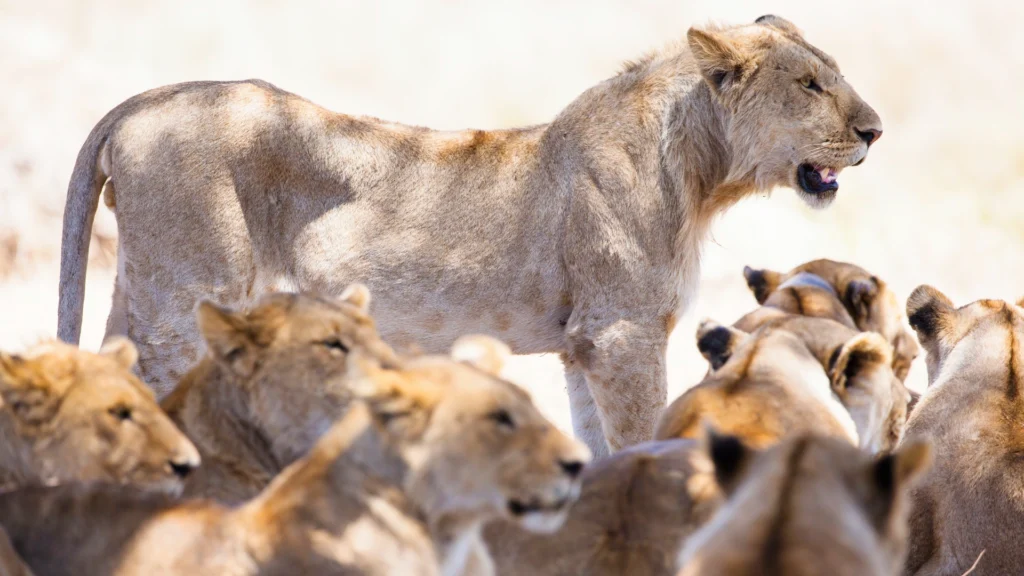
Many domestic cats like their privacy but lions thrive in groups called prides. A pride may consist of as few as four or as large as 40 members, but about 15 is more usual. The pride is often made up of several generations of lionesses (some of which are related), a dominant male and several subordinate males. All the females help raise each other’s cubs, and the cubs can suckle from any female with milk.8https://www.wwf.org.uk/learn/fascinating-facts/lions
Females are impressed by a marvellous mane
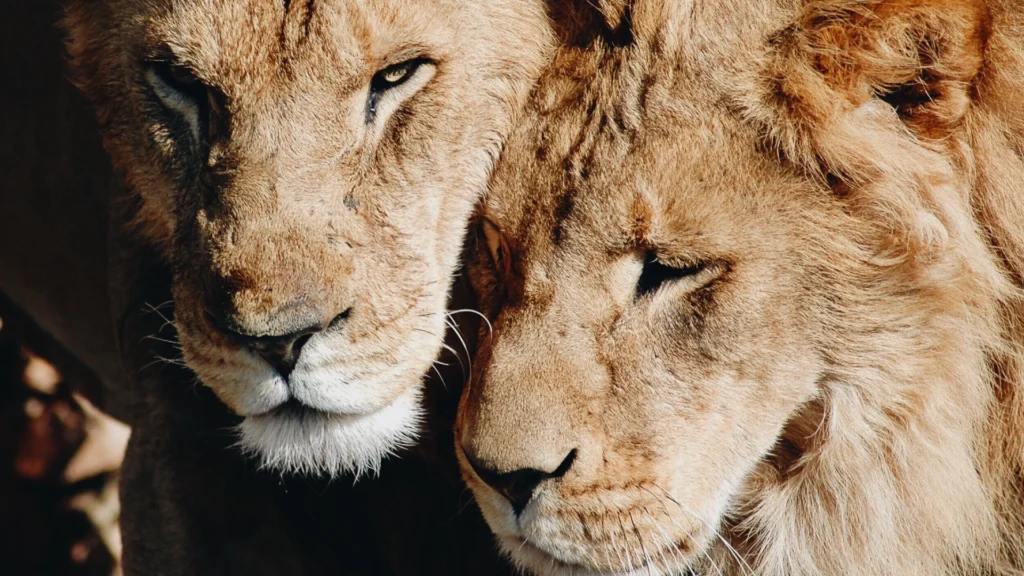
When it comes to a male lion’s mane, the bigger the better. A thick, luscious mane is a sign of dominance – it impresses the females and intimidates rival males.
Mum’s the word
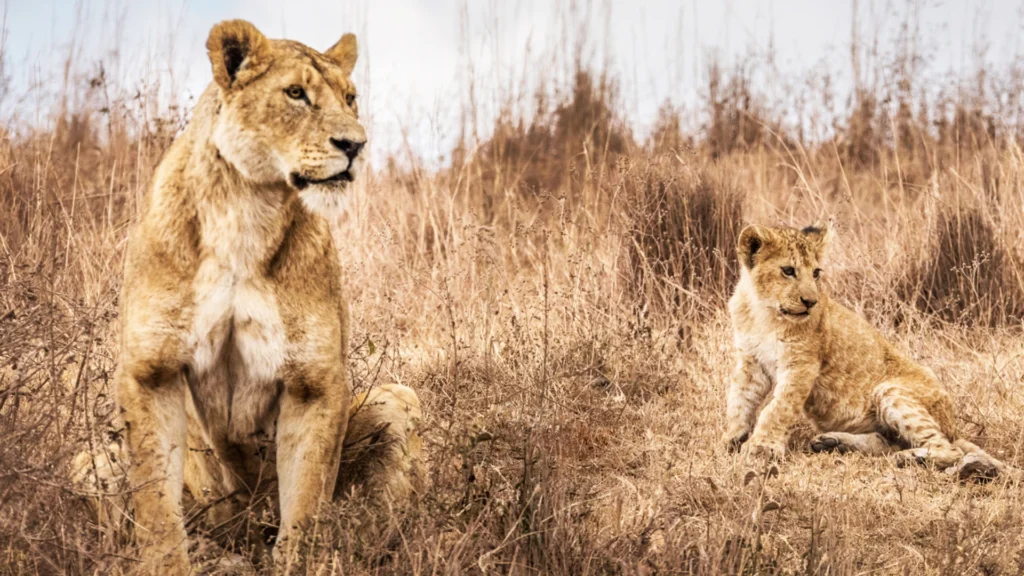
Females give birth to two to six cubs after a four-month pregnancy. The pregnant mother will run off to find somewhere private to give birth to her litter and will keep her cubs safe and secret for four to six weeks until they’re ready to meet the pride. Cubs raised in a pride are twice as likely to survive than cubs raised by a lone female which goes to show the power of family.7https://www.pbs.org/wnet/nature/blog/lion-fact-sheet/
Young lions start off spotty
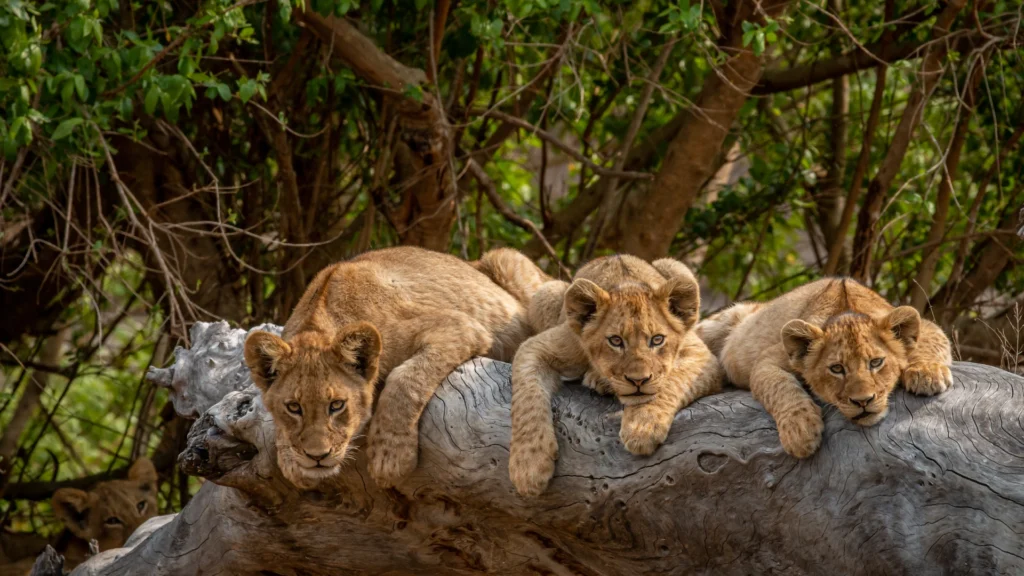
Lions are born with lots of little spots and stripes on their fur to help them camouflage with their surroundings. As they get older and stronger, and are no longer vulnerable to predators, the spots disappear and they turn from hunted to hunter.
Lions roar together
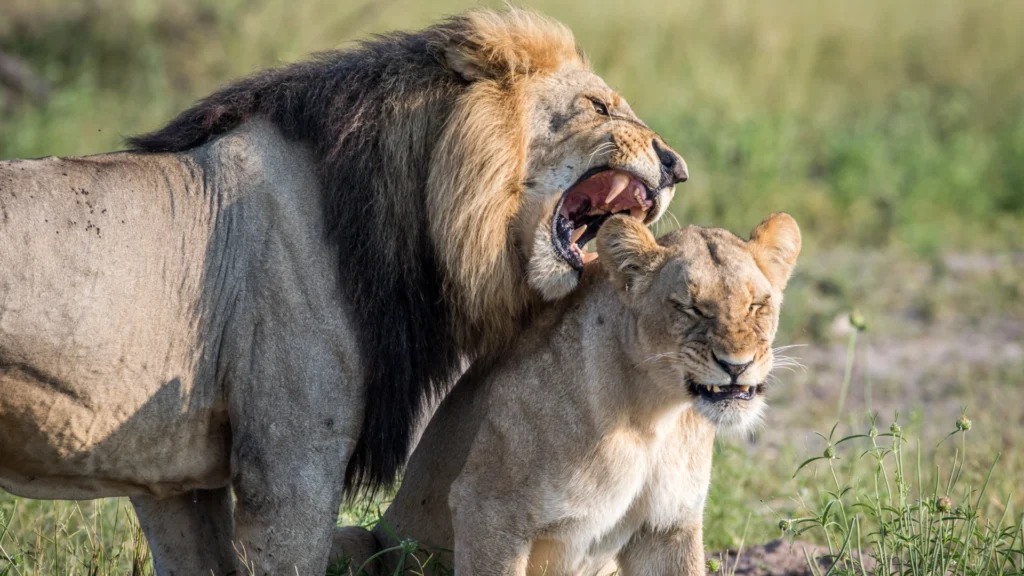
Like dogs howling at the moon, lions can be heard roaring together from as much as five miles away. They are the only cat species to roar together.8https://www.wwf.org.uk/learn/fascinating-facts/lions
Uganda’s lions are unique
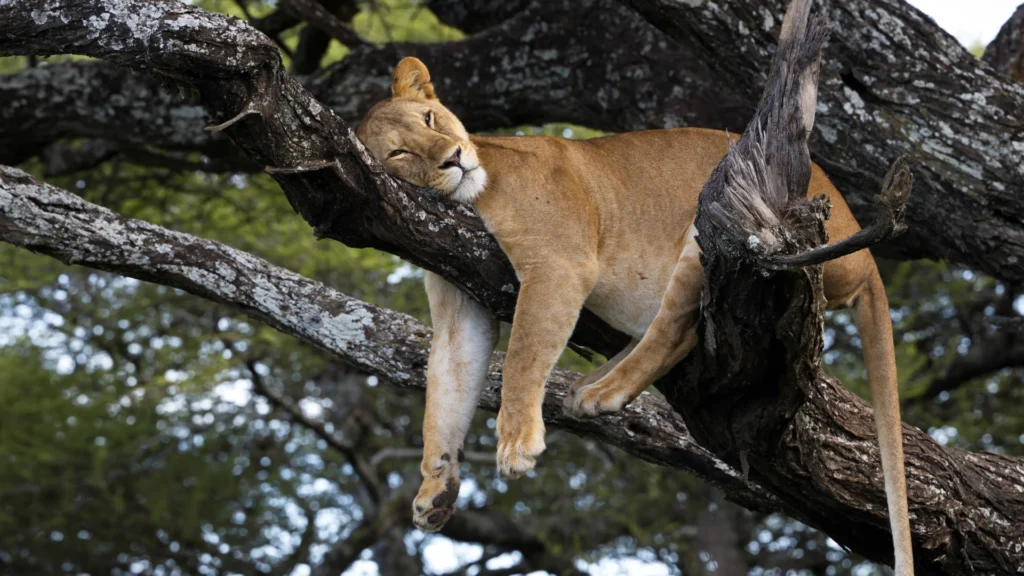
In Queen Elizabeth National Park, the lions have made a name for themselves by climbing trees – a very unusual habit for lions. Therefore, these lions have become known as the Ishasha tree-climbing lions.5https://uganda.wcs.org/Wildlife/Lions.aspx
Threats to lions
Hunting
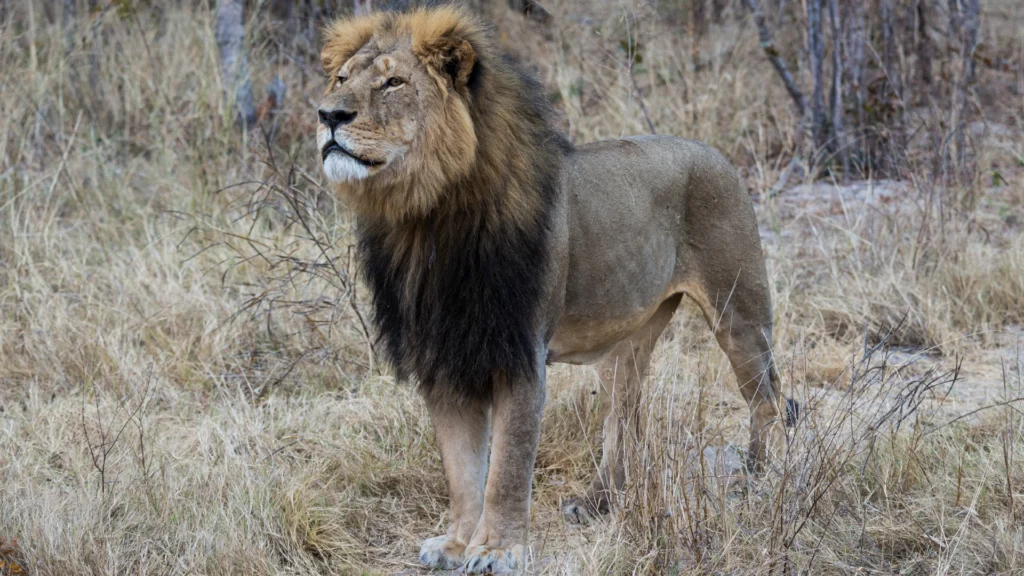
Although lions have no natural predators, humans have taken that role. Historically, lions have been the target of trophy hunters, cruel traditions and farmers. In 2015, the killing of Cecil the lion in Zimbabwe by American dentist, Walter Palmer, rightly shocked the world. This led to many countries tightening their trophy hunting laws but the United States is by far the biggest importer of lion ‘trophies’ in the world.9https://fivethirtyeight.com/features/the-united-states-is-the-biggest-importer-of-trophy-lions-like-cecil/ Sadly, the death of Cecil is far from an isolated event. In parts of Africa, lions are poached for their body parts, such as skins, claws, teeth and bones for a clear and growing Asian market.10https://lionrecoveryfund.org/threats-to-lions/ Originally it was tiger bones that were in demand for Chinese medicine, but as tigers have been poached to the brink of extinction, the unfortunate lion has taken its place.
The biggest threat to lions in Uganda though, and the main reason for their decline, comes from traps and snares used to hunt other animals such as antelopes. In fact, a shocking 71 per cent of adult lion deaths are caused by snares and other traps.5https://uganda.wcs.org/Wildlife/Lions.aspx In Murchison Falls National Park, in a two year period, five lions were found dead in illegal traps, while six lions were discovered seriously injured and required veterinary aid. Tragically three lost limbs, too severely injured by the snare to be saved. In Queen Elizabeth National Park, in a six-month period, three lions were rescued that had become painfully entangled in wire snares.
Efforts are ongoing to remove snares and traps from all of Uganda’s national parks but the rangers face an uphill battle. In Murchison falls, 80 per cent of the snare zone has yet to be surveilled and in order to do this, the rangers are in desperate need of resources, including up-to-date equipment and more personnel.5https://uganda.wcs.org/Wildlife/Lions.aspx In Queen Elizabeth National Park, the tracking of some lions has enabled rangers to save lions before they are trapped. By following the lions’ movements, the rangers can intervene and direct the lions back to the safety of the park when they come too close to human settlements and possible snare zones.5https://uganda.wcs.org/Wildlife/Lions.aspx
Habitat loss

The growing human population in Uganda is the primary cause of habitat loss for lions.11https://www.awf.org/wildlife-conservation/lion Because of this unsustainable rate of human expansion, lions have been pushed out of their habitat and now only have eight per cent of the land they once ruled.12https://www.wwf.org.uk/learn/wildlife/african-lions
As a result of Uganda’s population growth, increased urbanisation, and an increased income for wealthier Ugandans, the demand for animal products is likely to dramatically rise in the coming years. The FAO estimates that by 2050, the demand for meat and milk products in Uganda will more than double and “the production of all types of meat and that of milk will increase by 164 and 41 per cent, respectively.”13https://www.fao.org/3/ca7009en/CA7009EN.pdf
To produce these animal products, land that was once beautiful and iconic savannah and forest – and a home to Uganda’s majestic wildlife – is being turned into farmland. The conversion of land to agriculture is stripping the wildlife of its natural habitat and putting increasing pressure upon the land to support life. In the last one hundred years, Uganda has lost 42 per cent of its forest cover, decreasing from 54 per cent to 12 per cent in 2017.14https://illuminem.com/illuminemvoices/deforestation-in-uganda-causes-and-recommendations Encroachment into Queen Elizabeth National Park by illegal cattle ranchers is common15https://conbio.onlinelibrary.wiley.com/doi/abs/10.1111/cobi.12538?campaign=woletoc and the National State of the Environment Report for Uganda 2014, attributes this to “the increasing demand of land for agriculture and fuel wood by the rapidly increasing population growth.”16https://nema.go.ug/sites/all/themes/nema/docs/FINAL%20NSOER%202014.pdf
Of course, a growing population needs food but it would be much more sustainable to meet these needs through the growing of crops instead farming animals. Animal foods require by far the most land and resources – this is because land is not only used for grazing but also for growing food for the animals. The more animal-based foods we eat, the more endangered our forests become. However, crops are a far more efficient way to feed the growing population and use less land and other natural resources. A vegan diet is associated with only half the cropland demand, grazing intensity and overall biomass harvest of meat-based diets17https://www.nature.com/articles/ncomms11382 so switching to a vegan diet would have a phenomenal impact on reducing deforestation and land degradation in Uganda.
Human-wildlife conflict

As humans continue to encroach on the territory of lions, conflict ensues. Many lions are deliberately poisoned by livestock farmers to try to protect their cattle. Lions do most of their hunting at night when farmed animals are not being watched over by farmers. In a callous act of revenge, farmers leave out cattle carcasses soaked in poison so that any animal that feeds on it will die. This doesn’t just affect lions, but any scavenging animal such as hyenas and vultures.5https://uganda.wcs.org/Wildlife/Lions.aspx
Humans also take revenge on lions if lions injure or pose a threat to human settlements. As the human population around Queen Elizabeth National Park grows, interactions between humans and lions become more common. It is not the lions’ fault that humans are invading their territory, but they are the ones who suffer. Many lions have been speared to death by local people who feel threatened by the lions’ presence. 5https://uganda.wcs.org/Wildlife/Lions.aspx
Exploitation of natural resources
Unfortunately, for all the wildlife that lives there, huge amounts of oil have been found under Murchison Falls, Uganda’s largest national park and Uganda’s President Museveni endorsed the East African Crude Oil Pipeline project.18https://www.aljazeera.com/features/2022/7/15/oil-drilling-continues-in-ugandan-park-despite-threat-to-nature The National Park is home to more threatened and endemic species than any other region in Africa but it is all put at risk in the name of money. Despite worldwide opposition by conservationists, French oil company TotalEnergies began drilling in the park in 2023.19https://www.afrik21.africa/en/uganda-totalenergies-begins-drilling-for-oil-in-the-murchison-falls-national-park/ There is no doubt that whatever feeble claims are made, the wildlife and landscape of Murchison Falls National Park will be irreversibly damaged.
References
References
- 1
- 2
- 3
- 4
- 5
- 6
- 7
- 8
- 9
- 10
- 11
- 12
- 13
- 14
- 15
- 16
- 17
- 18
- 19

